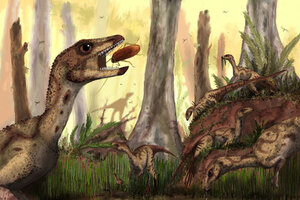Were early dinosaurs herd animals? New discovery points to dino-gregariousness.
A fox-sized dinosaur unearthed in Venezuela lends support to the belief that dinosaurs lived in herds early on in their evolution.

An artist's impression of the dinosaur Laquintasaura venezuelae, which lived some 200 million years ago in what is now Venezuela.
© Mark Witton
The fossil of a new two-legged, fox-sized dinosaur relative of both Stegosaurus and Triceratops, which dates back about 200 million years, has been discovered in Venezuela. The find suggests that dinosaurs advanced quickly across the globe after a mass extinction claimed at least half of all species on Earth, researchers say.
This new fossil, the first named dinosaur unearthed from northern South America, also provides evidence that dinosaurs lived in herds early on in their evolution, and were able to dwell in regions previously thought too inhospitable for dinosaurs to survive.
The new dinosaur is named Laquintasaura venezuelae. Laquintasaura is Greek for "lizard of La Quinta," the rock formation where the reptile was discovered in the Andes, while venezuelae refers to the country of Venezuela, where the dinosaur was unearthed. [See Images of the Newfound Little Dinosaur]
The dinosaur was about 3 feet (1 meter) long and only stood up to about 1 foot (0.3 m) high. Judging by its teeth, it was an omnivore.
"The teeth are very unusual, with a tall, narrow triangular outline, tips that are slightly curved backward, coarse serrations along the margins and thin ridges that extend up and along the crown," said lead study author Paul Barrett, a vertebrate paleontologist at the Natural History Museum in London. "This combination of features is unknown in any other dinosaur. Although the triangular shape and coarse serrations suggest that plants made up most of the diet, the tall outline is reminiscent of meat-eating teeth, as are the slightly curved tips, so it is possible that Laquintasaura took small prey such as large insects some of the time."
Laquintasaura was an ornithischian or "bird-hipped" dinosaur, an early relative of titans such as duck-billed hadrosaurs, the armored stegosaurs and ankylosaurs, and three-horned Triceratops. The other major dinosaur lineage were the saurischian or "lizard-hipped" dinosaurs, which included giant long-necked sauropods such as Brachiosaurus and predatory theropods such as Velociraptor and T. rex. (Birds actually evolved from saurischians, not the so-called bird-hipped ornithischians.)
Laquintasaura lived about 200 million years ago, "placing it in the earliest part of the Jurassic period, a time when dinosaurs were just starting their ascent to global dominance," Barrett told Live Science.
This dinosaur was alive soon after the end-Triassic mass extinction event. This mass extinction was one of the big five mass extinctions to affect life on Earth — the most recent one, the end-Cretaceous, which was about 67 million years ago, ended the age of dinosaurs. Dinosaurs originated about 230 million years ago, in the late Triassic, but only achieved global dominance beginning 30 million years later, after the cataclysmic end of the Triassic. [Wipe Out! History's 7 Most Mysterious Extinctions]
"In many ways, this extinction was a major help to dinosaurs, as it killed off a number of other reptile groups that might have been competitors," Barrett said. "Laquintasaura is known only 500,000 years after the extinction, and shows that ornithischians were quick off the mark during this recovery period."
Recently, scientists have unearthed a trove of early saurischian dinosaurs, such as meat-eating Eodromaeus and plant-eating Eoraptor. However, early ornithischian fossils have proven quite scarce — this new discovery helps fill a major gap in what scientists know of dinosaur evolutionary history.
At least four specimens of Laquintasaura were uncovered together. This finding suggests that ornithischians may have practiced herd behavior early in their evolution. Until now, complex social behavior among ornithischians was confirmed only in dinosaurs of the Late Jurassic onward, dozens of millions of years after Laquintasaura was alive.
In addition, Laquintasaura apparently lived near the equator, which past research suggested was inhospitable to dinosaurs.
"Climate models had suggested that the equatorial regions may have been isolated from other regions by extensive deserts on either side, which may have acted as a barrier to prevent large animals reaching this region," Barrett said. "However, plant fossils from the area, and the discovery of Laquintasaura, suggest that the climate must have been capable of supporting at least some animals for at least part of the year, though it's unclear just how hospitable the area was all year round."
A couple of fossil teeth the researchers discovered from another species "demonstrate that a meat-eating dinosaur was also present, but these teeth are the only evidence that we found for such an animal. No other fossils from other animal groups have been found," Barrett said.
Many other details remain unknown about what the area was like when this dinosaur lived.
"Some of the rocks in the general area of the discovery represent semiarid environments, while others indicate more swampy environments," Barrett said. "The climate would have been hot, but the amount of water would have varied through time."
In the future, "it would be interesting to do more work on the specific environment that the bones come from, as well as the processes that concentrated the bones into the rich jumbled layer that was found," Barrett said.
The scientists detailed their findings online Aug. 6 in the journal Proceedings of the Royal Society B.
Follow us @livescience, Facebook & Google+. Original article on Live Science.
- Image Gallery: Dinosaur Daycare
- Paleo-Art: Dinosaurs Come to Life in Stunning Illustrations
- 5 Fossil Hotspots: National Parks to Visit
Copyright 2014 LiveScience, a TechMediaNetwork company. All rights reserved. This material may not be published, broadcast, rewritten or redistributed.

